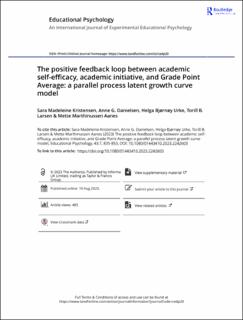| dc.contributor.author | Kristensen, Sara Madeleine | |
| dc.contributor.author | Danielsen, Anne G | |
| dc.contributor.author | Urke, Helga Bjørnøy | |
| dc.contributor.author | Larsen, Torill Marie Bogsnes | |
| dc.contributor.author | Aanes, Mette | |
| dc.date.accessioned | 2023-10-03T08:11:28Z | |
| dc.date.available | 2023-10-03T08:11:28Z | |
| dc.date.created | 2023-08-29T13:57:38Z | |
| dc.date.issued | 2023 | |
| dc.identifier.citation | Educational Psychology. 2023, 43 (7), 835-853. | en_US |
| dc.identifier.issn | 0144-3410 | |
| dc.identifier.uri | https://hdl.handle.net/11250/3093668 | |
| dc.description.abstract | This study investigates the associations between students’devel-opmental changes in academic self-efficacy, academic initiative,and grade point average (GPA) during a three-year upper second-ary education. The sample consisted of 1453 students aged 16–19(60.6% girls; baseline mean age¼17.00,SD¼.91; 56.1% highperceived family wealth; and 74.9% Norwegian-born). To explorehow changes in academic self-efficacy, academic initiative, andGPA were related, we investigated a theoretical parallel processlatent growth curve model. The results implied that, during uppersecondary school, academic self-efficacy declined, while academicinitiative and GPA remained stable. We found possible ceilingeffects within and between several of the study’s constructs. Themain finding was support for a positive feedback loop betweenthe developmental trajectories of academic self-efficacy, academicinitiative, and GPA. The present study adds new insight thatshould be taken into consideration when promoting positive edu-cational development during late secondary school. | en_US |
| dc.language.iso | eng | en_US |
| dc.publisher | Taylor & Francis | en_US |
| dc.rights | Attribution-NonCommercial-NoDerivatives 4.0 Internasjonal | * |
| dc.rights.uri | http://creativecommons.org/licenses/by-nc-nd/4.0/deed.no | * |
| dc.subject | academic self-efficacy | en_US |
| dc.subject | academic initiative | en_US |
| dc.subject | gradepoint average | en_US |
| dc.subject | parallelprocess growth model | en_US |
| dc.subject | structural equation modelling | en_US |
| dc.title | The positive feedback loop between academic self-efficacy, academic initiative, and grade point average: a parallel process latent growth curve model | en_US |
| dc.title.alternative | The positive feedback loop between academic self-efficacy, academic initiative, and grade point average: a parallel process latent growth curve model | en_US |
| dc.type | Peer reviewed | en_US |
| dc.type | Journal article | en_US |
| dc.description.version | publishedVersion | en_US |
| dc.rights.holder | The Authors | en_US |
| dc.source.pagenumber | 835-853 | en_US |
| dc.source.volume | 43 | en_US |
| dc.source.journal | Educational Psychology | en_US |
| dc.source.issue | 7 | en_US |
| dc.identifier.doi | 10.1080/01443410.2023.2242603 | |
| dc.identifier.cristin | 2170591 | |
| cristin.ispublished | true | |
| cristin.fulltext | original | |
| cristin.qualitycode | 2 | |

